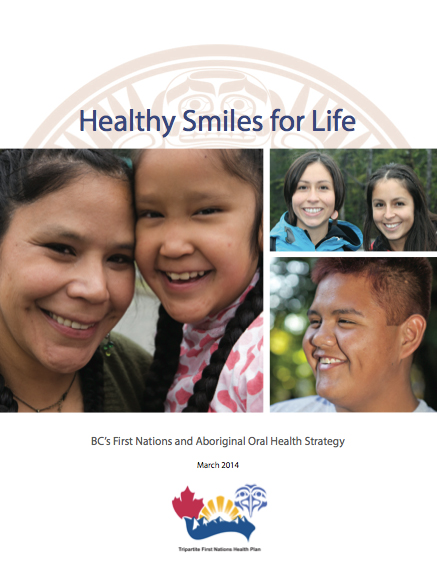Healthy Smiles for Life: BC’s First Nations and Aboriginal Oral Health Strategy
 Healthy Smiles for Life was developed with the leadership of the Ministry of Health in collaboration with First Nations Health Authority (FNHA), Health Canada and Regional Health Authorities. The guide is designed to inform public health and community planning, policy development and program implementation.
The Executive Summary of the Strategy states: “Oral health is essential to overall health and wellness. Children’s oral health is significantly impacted by maternal oral health and the knowledge and oral health practices of caregivers and families. Aboriginal children in BC have significantly poorer oral health than non-Aboriginal children, and First Nations children living on-reserve have even poorer oral health than Aboriginal children living off reserve.”
Healthy Smiles for Life was developed with the leadership of the Ministry of Health in collaboration with First Nations Health Authority (FNHA), Health Canada and Regional Health Authorities. The guide is designed to inform public health and community planning, policy development and program implementation.
The Executive Summary of the Strategy states: “Oral health is essential to overall health and wellness. Children’s oral health is significantly impacted by maternal oral health and the knowledge and oral health practices of caregivers and families. Aboriginal children in BC have significantly poorer oral health than non-Aboriginal children, and First Nations children living on-reserve have even poorer oral health than Aboriginal children living off reserve.”
The guide was developed in relation to three pieces of earlier work developed by the FNHA and Ministry of Health:
- Environmental Scan of Oral Health Services for First Nations and Aboriginal Children 0-7 years
- Oral Health Resource Materials
- Dental Survey of Aboriginal Kindergarten-Aged Children 2009-2010
Healthy Smiles for Life identifies six strategic directions for ongoing collaborative efforts:
- Oral Health Promotion
- Prevention and Identification of Caries Risk
- Access to Treatment
- Leadership and Collaborative Action
- Surveillance, Monitoring and Evaluation
- Human Resources
Healthy Smiles for Life identifies five principles to guide collaborative work for improving oral health for First Nations and Aboriginal children in BC:
- Health Equity: Create equal opportunities for good oral health for all, and reduce disparities in oral health among population groups.
- Cultural Competence and Responsiveness: Ensure that oral health care providers are culturally competent, and provide culturally responsive oral health promotion and prevention services.
- Holistic Health and Wellness: Promote oral health as part of a holistic health and wellness strategy. Shift from a sickness model to a wellness model.
- Healthy Children, Healthy Families and Healthy Communities: Recognize that Elders and other community members play an important role in the health of First Nations and Aboriginal children. Promote collective community efforts to foster equity, dignity and wellbeing for children and their families.
- Working Together: Establish strong communication and partnerships between First Nations and Aboriginal communities and public health oral health care providers. Foster community channels for reaching children and their caregivers and families.
Promoting oral health and preventing cavities and other related dental issues for children begins at birth and has lasting impacts on their healthy development and long term health and wellness.
